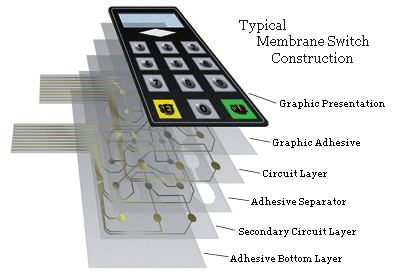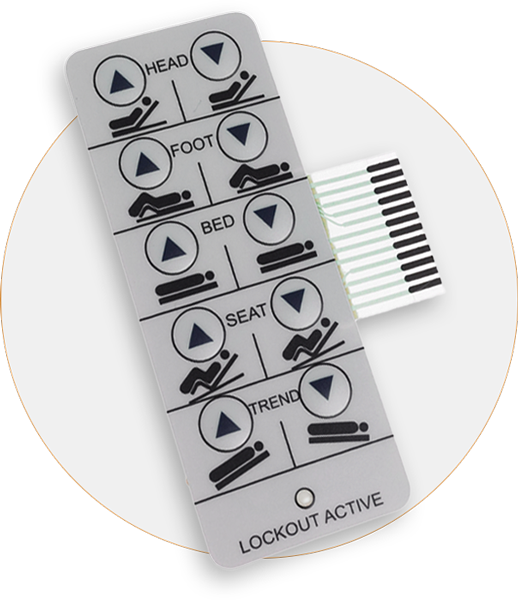Every well-executed product line begins with partnering with the right membrane switch manufacturer early on.
Every well-executed product line begins with partnering with the right membrane switch manufacturer early on.
Blog Article
All Regarding Membrane Layer Switch Over: Recognizing Its Style and Performance
When you think concerning the control user interfaces in modern-day devices, membrane switches typically come to mind. Let's discover what sets membrane switches apart from other control systems.
What Are Membrane Layer Switches?

Membrane layer buttons can additionally be tailored pertaining to shape, size, and graphics, enabling suppliers to produce unique interfaces tailored to particular products. Generally, membrane layer buttons play a considerable function in enhancing customer experience across a vast array of applications.
Just How Membrane Changes Work
When you press a secret on a membrane layer button, it activates an uncomplicated yet efficient device. membrane switch manufacturer. The leading layer, frequently made of flexible product, presses down onto a conductive layer below it.
You'll observe that the tactile responses differs based on the switch style, providing either a soft click or a more pronounced response. Once you launch the secret, the membrane layer go back to its original position, reopening the circuit and quiting the signal. This procedure takes place practically instantaneously, making certain a receptive individual experience.
Membrane layer buttons are popular because of their toughness and resistance to dust and dampness, making them ideal for different applications, from home devices to clinical devices. Recognizing this operation assists you appreciate their extensive usage.
Key Components of Membrane Layer Buttons
Understanding the crucial elements of membrane layer switches is fundamental for grasping their functionality and style. The protective layer guards versus environmental aspects and put on, prolonging the switch's lifespan. By comprehending these components, you'll obtain insight into how membrane changes operate and their importance in different applications.
Materials Utilized in Membrane Switch Over Design
The performance and sturdiness of membrane layer switches over heavily rely on the materials used in their layout. You commonly come across polyester and polycarbonate as primary substrates because of their superb toughness and versatility. These materials withstand scrapes and chemicals, making them excellent for demanding settings.
The conductive layers frequently use silver or carbon, selected for their dependability and conductivity. membrane switch manufacturer. Silver provides premium efficiency, while carbon is a cost-efficient option. For the overlay, you could think about a matte or shiny surface, relying on your aesthetic demands and individual experience
Adhesives play a vital function also; they bond layers securely and guarantee durability. Make sure to pick adhesives that stand up to environmental variables like temperature and humidity. Finally, don't forget the importance of an excellent printing method for graphics, as it improves both performance and visual charm. Choosing the best products will certainly guarantee your membrane layer button stands the test of time.
Design Considerations for Membrane Buttons
While designing membrane layer switches, it's crucial to take right into account numerous aspects that influence their functionality and customer experience. Beginning by focusing on the design and switch dimension; make specific they're intuitive and simple to browse.
Don't overlook the graphic style; clear labeling and shade contrast are considerable for exposure. Validate your layout accommodates ecological factors, like dampness or temperature level variations, which might affect efficiency. Lastly, keep in mind the significance of testing models with actual users to collect comments and make needed adjustments. This iterative procedure assists you refine the design, verifying it meets both functional and visual demands properly. By thoroughly taking into consideration these elements, you'll produce a membrane button that enhances functionality and satisfaction.
Applications of Membrane Layer Buttons
Membrane layer switches are flexible components located in different applications, from commercial tools to customer electronic devices. You'll see their impact in machines that call for durable interfaces and in tools that take advantage of smooth designs. Recognizing these applications helps you value the capability and usefulness of membrane buttons in everyday innovation.
Industrial Equipment Usage
When you're looking to boost the capability of industrial tools, membrane layer buttons provide a reputable service that incorporates sturdiness with easy to use design. These buttons are perfect for extreme environments, supplying resistance to dirt, moisture, and chemicals. Welcome membrane buttons to streamline your operations and improve overall performance.
Consumer Electronic Devices Assimilation
In the domain of consumer electronic devices, membrane layer switches play a crucial role in boosting customer interaction and gadget functionality. You'll find them in devices like microwaves, remote controls, and pc gaming consoles, offering a seamless means to interact with modern technology. Their sleek layout allows for easy integration into various products, making controls intuitive and straightforward. With their capacity to incorporate graphics and backlighting, you can enjoy a modern visual that complements the tool's total appearance. Membrane switches also ensure resilience and resistance to dirt and moisture, expanding the life-span of your electronic devices. By picking membrane switches, you improve not just the capability but likewise the navigate here style of your devices, making day-to-day interactions smooth and enjoyable.
Advantages and Downsides of Membrane Switches
While membrane layer switches supply a variety of advantages, they likewise feature some drawbacks that you must take into consideration. One substantial advantage is their compact layout, making them optimal for space-constrained applications. They're also affordable, supplying a long lasting solution with a reduced manufacturing expense. Furthermore, their smooth surface is easy to tidy, enhancing health in environments like medical facilities.

Membrane buttons can have a shorter life expectancy contrasted to mechanical switches, particularly under hefty use. They can also be much less responsive, which might impact customer comments throughout procedure. Balancing these pros and disadvantages will help you determine if membrane layer buttons are the appropriate fit for your job.
Regularly Asked Inquiries
For How Long Do Membrane Switches Commonly Last?
Membrane switches commonly last in between 5 to ten years, depending on usage and ecological problems. You'll wish to assess variables like wear, direct exposure to moisture, and temperature level fluctuations to assess their durability properly.
Can Membrane Changes Be Custom-made for Specific Designs?
Yes, you can personalize membrane layer switches to fit details styles (membrane switch manufacturer). You'll have the freedom to choose colors, forms, and formats that match your project's investigate this site demands, ensuring they mix perfectly with your total aesthetic
What Is the Price Array for Membrane Layer Switch Over Manufacturing?
The cost variety for membrane layer button manufacturing normally drops in between $1 and $10 each, depending on factors like style complexity, amount, and products. You can get quotes from makers to discover the very best choice.

Are Membrane Changes Water-proof or Immune?
Membrane layer switches can be designed to be waterproof or resistant, depending upon materials utilized and building and construction approaches. If you require them for damp settings, assure you define those needs during the style process.
Just How Do Membrane Switches Over Contrast to Traditional Switches?
Membrane layer buttons are normally thinner and find more information much more flexible than standard switches, using a smooth style. They're frequently much easier to clean up and integrate, yet may not provide the tactile feedback you're utilized to with mechanical options.
Verdict

Report this page